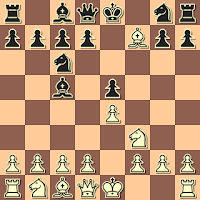Chessfriend Roger sent another one of his interesting internet Jerome Gambits.
Playing over the game, I was fascinated by White's "self-inflicted" backward pawn at e4 - and, apparently, Black was, too, as he quickly jumped a Knight into the created "hole".
Ah, but we should have been watching the advancing f-pawn, which spearheaded an attack which crashed on through.
A very interesting lesson!
RK -KM
Internet, 2016
1.e4 e5 2.Nf3 Nc6 3.Bc4 Bc5 4.Bxf7+
4...Kxf7 5.Nxe5+ Nxe5 6.d4 Bxd4 7.Qxd4 d6 8.O-O Ne7
9.Nc3 Rf8 10.Bg5 Kg8 11.f4 N5c6 12.Qd3 a6
Black looks comfortable. He needs to find a way to develop his Bishop, and then the Queenside Rook. Too many times the Jerome Gambit defender finds himself down those two pieces, as they remain out of action and unable to help meet an attack. Fair warning!
13.Qg3 Qe8 14.f5 Ne5
Who can argue with that wonderful Knight on e5? Fine, let him have his day of glory, but pay attention to what else is going on.
15.f6 N7g6 16.Nd5 Qd7
Not the best defensive move. Also, see the note to move 12.
17.fxg7 Kxg7 18.Rxf8 Kxf8 19.Rf1+ Nf7 20.Bh6+ Ke8
It looks like Black has missed the fact that this move will lose his Queen, but if the King had gone to g8 the Queen would soon be lost, anyhow - and the King checkmated, to boot.
21.Nf6+ Kd8 22.Nxd7 Bxd7 23.Rxf7 Black resigned
In the Jerome Gambit White gives up a piece or two for a couple of pawns. Often he must rely on those pawns for active play against his opponent. In the following game the play first seems less-than-active, but that eventually changes, much to Black's misfortune.
IgorSolonicin -prokaznik
4 5 blitz, lichess.org, 2016
1.e4 e5 2.Nf3 Nc6 3.Bc4 Bc5 4.Bxf7+
4...Kxf7 5.Nxe5+ Nxe5 6.Qh5+ Ng6 7.Qd5+ Ke8 8.Qxc5 d6 9.Qe3 Nf6 10.f3
Steinitz said that the player with the advantage must attack, or risk losing that advantage. White prepares to face that attack, relying on solid "Jerome pawns" instead of planning an attack of his own with f2-f4.
10...Kf7 11.O-O
Equally good is 11.d4 as in Wall,B - Guest3544144, PlayChess.com, 2013 (1-0, 35)
11...Rf8
Or 11...Re8 12.h3 Kg8 13.d4 Be6 14.d5 Bd7 15.Nc3 a6 16.Qg5 Bb5 17.Re1 Bd7 18.Qg3 Ne5 19.Qf2 Ng6 20.Bg5 Rf8 21.e5 dxe5 22.Rxe5 h6 23.Ne4 hxg5 24.Rxg5 Nxe4 25.Rxg6 Qg5 26.Rxg5 Nxf2 27.Kxf2 Bf5 28.Re1 g6 29.Re7 Rf7 30.Rxc7 Kg7 31.d6 Rxc7 32.dxc7 Rc8 33.g4 Rxc7 34.gxf5 Rxc2+ 35.Kg3 Kf6 36.Rxg6+ Kxf5 37.Rg7 Ke5 38.Rxb7 Kd4 39.Rb3 Rc3 40.Rxc3 Black forfeited on time, Alekarpo - ImKindOfAlright, lichess.org, 2016.
Also, 11...Be6 was seen in Wall,B - Guest1105387, PlayChess.com, 2014 (1-0, 30).
12.Qb3+ d5 13.d4 Kg8 14.e5
Or 14.Nc3!?
14...Nh5 15.g3 b6 16.Qe3 Ba6 17.Re1 Qe8 18.f4 Ne7
Black misses his chance. He should try 18...Nhxf4 19.gxf4 Nxf4 20.Qg3 Ne2+ 21.Rxe2 Bxe2.
19.Qf3 g6 20.Nc3 Ng7 21.Nxd5 Qd8 22.Nxe7+
Or 22.Nf6+!? Kh8 23.d5.
22...Qxe7 23.c3 c5 24.d5
24...c4 25.Be3 Bb7 26.Kf2 Nf5 27.Rad1 Rad8 28.d6 Bxf3 29.dxe7 Nxe7
Missing the important 29...Bxd1 30.exf8=Q+ Kxf8 and giving up his advantage.
30.Kxf3 Nf5 31.Bd4 Rd5 32.g4 Nxd4+ 33.Rxd4 Rfd8 34.Red1
Rxd4 35.Rxd4 Rxd4 36.cxd4
36...Kf7 37.d5 b5 38.Ke3 a5 39.Kd4 h6 40.h4 Ke7 41.Kc5 Black resigned
After a tough loss with the Jerome Gambit (1.e4 e5 2.Nf3 Nc6 3.Bc4 Bc5 4.Bxf7+) in the ongoing Giuoco Piano thematic tournament at Chess.com - outplayed by an opponent 200 or 300 rating points above me (not the usual "Jerome Gambit odds") - I like to play through games like the following one, where White seems to always come up with something, even in the most dire of circumstances, and in a three minute game, too!
RobertoRufino - laumassambani
3 0 blitz, lichess.org, 2016
1.e4 e5 2.Nf3 Nc6 3.Bc4 Bc5 4.Bxf7+
4...Kxf7 5.d4 exd4 6.Ng5+
I never understand how people get away with Ng5+ in the Jerome. Probably I should find out.
6...Kf8 7. Qf3+ Qf6 8.Qg3 d6
9.Nd2 Nge7 10.O-O h6 11.Kh1 hxg5 12.f4 Ke8 13.Nc4 gxf4 14.Bxf4 Be6
15.Bxd6 Qh6 16.Bxc5 Kd7 17.Ne5+ Nxe5 18.Qxe5 Nc6
19.Qg3 b6 20.Bxd4 Rh7 21.Rad1 Ke7
And, just like that, White has a forced checkmate. Wonderful!
22.Be3 Qh5 23.Bg5+ Ke8 24.Qxc7 g6 25.Qxc6+ Bd7 26.Qxa8+ Bc8 27.Qxc8 checkmate



















